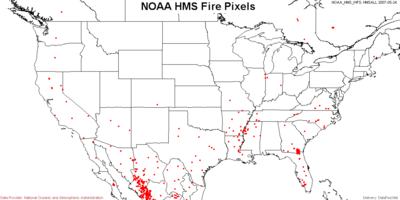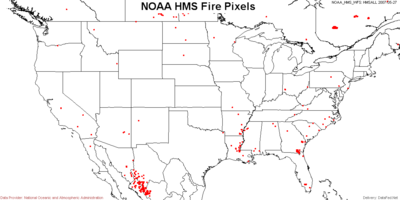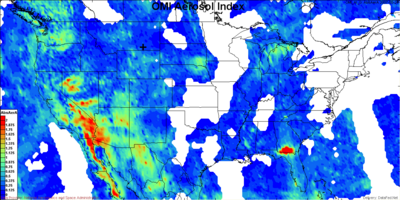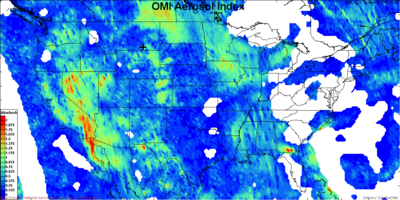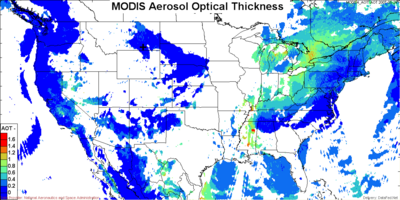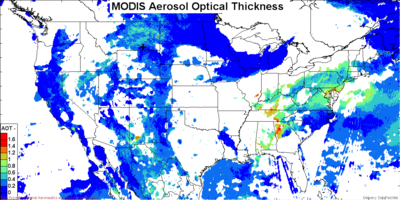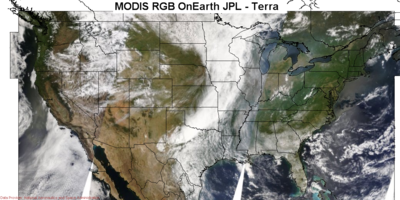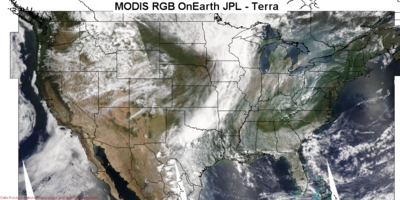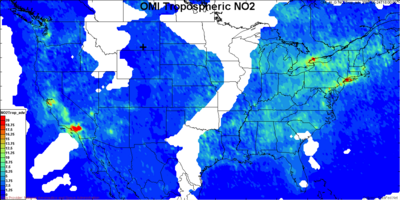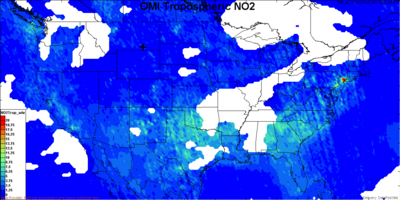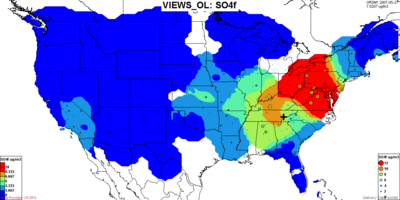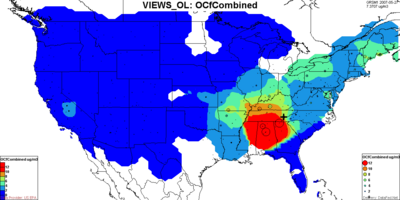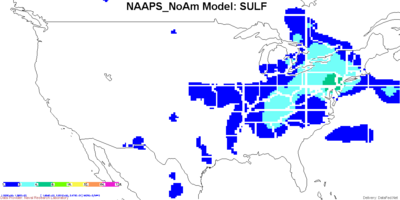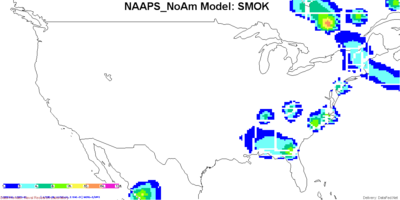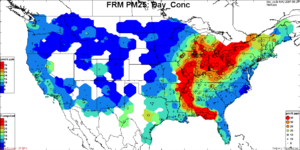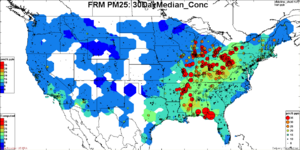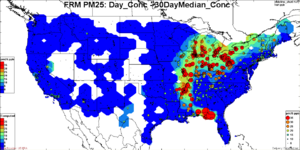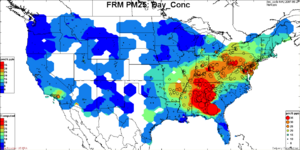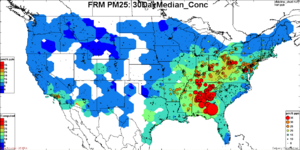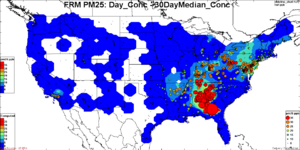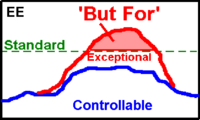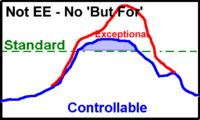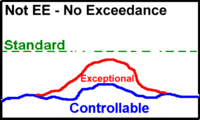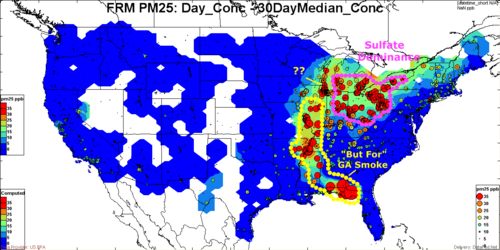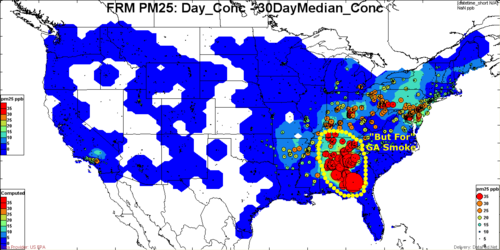Difference between revisions of "Evidence for Flagging Exceptional Events"
| Line 142: | Line 142: | ||
=== 5. The Exceedance or Violation would not Occur, ''But For'' the Exceptional Event === | === 5. The Exceedance or Violation would not Occur, ''But For'' the Exceptional Event === | ||
| − | According to the EE Rule, observationas can be EE-flagged if the violation is caused by the exceptional event. | + | According to the EE Rule, observationas can be EE-flagged if the violation is caused by the exceptional event. Considering the subtleties of the EE Rule, below are graphical illustrations of the Exceptional Events criteria. |
* The leftmost figure shows a case when the 'exceptional' concetration raises the level above the standard. A valid EE to be flagged. | * The leftmost figure shows a case when the 'exceptional' concetration raises the level above the standard. A valid EE to be flagged. | ||
* In the next case, the concentration from controllable sources is sufficient to cause the exceedance. This is not a 'but for' case and should not be flagged. | * In the next case, the concentration from controllable sources is sufficient to cause the exceedance. This is not a 'but for' case and should not be flagged. | ||
* In the third case, there is no exceedance. Hence, there is no justification for an EE flag. | * In the third case, there is no exceedance. Hence, there is no justification for an EE flag. | ||
| + | |||
[[Image:EE_ButForSchematics.png|200px|The 'exceptional' concetration raises the level above the standard]] | [[Image:EE_ButForSchematics.png|200px|The 'exceptional' concetration raises the level above the standard]] | ||
[[Image:Image-EE NoButFor1Schematics.png|200px|The 'exceptional' concetration raises the level above the standard]] | [[Image:Image-EE NoButFor1Schematics.png|200px|The 'exceptional' concetration raises the level above the standard]] | ||
[[Image:Image-EE NoButFor2Schematics.png|200px|The 'exceptional' concetration raises the level above the standard]] | [[Image:Image-EE NoButFor2Schematics.png|200px|The 'exceptional' concetration raises the level above the standard]] | ||
<br> | <br> | ||
| − | + | ||
| + | ---- | ||
| + | |||
[[Image:070524_FRM_PM25 BurFor.png|500px]] [[Image:070527_FRM PM25_BurFor.png|500px]] | [[Image:070524_FRM_PM25 BurFor.png|500px]] [[Image:070527_FRM PM25_BurFor.png|500px]] | ||
Revision as of 22:19, April 11, 2008
< Back to Exceptional Event Workspace
GA Smoke Exceptional Event Console
What Evidence is Required to Flag an Exceptional Event? (EE)
The Exceptional Events Rule requires states that flag data to satisfy the requirements of 40 CFR 50.14 (c)(3)(iii) to provide evidence that:
- The sample is a likely exceedance
- The event satisfies the criteria that it was not reasonably controllable or preventable
- There is a clear casual relationship between the measured value and the event
- The event is associated with a measured value in excess of historical values.
- There would have been no exceedances or violation but for the event.
In the following analysis, we will use the May 2007 Georgia Swamp Fire to illustrate the impact of an exceptional event on the PM2.5 concentration over the eastern U.S. The smoke from this event has impacted multi-state regions, which are also receptors of major anthropogenic sulfate sources. The tools and methods illustrated here allow the determination of which potential exceedances are attributable to the exceptional event and anthropogenic sources, respectively.
The illustrative analysis will focus on May 24, 2007. The images below are generated by tools. Adjacent to each image is a link to the tool used with settings corresponding to those used in the image. This allows the users to use these tools for the exploration of exceptional events that occur on other days.
1. Is there a likely exceedance?
The first step is to establish that a sample is a likely contributor to noncompliance. Exceptional events flags are appropriate for samples that are likely to cause an exceedance. A site is in noncompliance if the 98 percentile of the PM2.5 concentration over a three year period is over 35 ug/m3. However, a site is in compliance if the number of PM2.5 > 35ug/m3 samples is less than 2 percent.
Screening for Potential PM2.5 Exceedances
The PM2.5 samples that are potential contributors to non-compliance can be determined visually by the PM2.5 Exceedance Screening Tool. The data browser tool has a map view and a time series view. The map view shows the PM2.5 concentration as colored circles for each station for a specific date. The time view of the browser shows the concentration time series for a selected site. The selection of time for the map view can be accomplished by entering the desired date in the date box or clicking the date in the time view. The selection of the station for the time series is accomplished either by choosing from the station list box or clicking on the station in the map view. (Note:Description of generic DataFed browser needed). The coloring of the PM2.5 concentration values (circles) is adjusted such that the concentrations above 35ug/m3 are shown in red. This provides an easy and obvious (to everyone except Neil) way to identify the candidate samples for noncompliance.
Browser for: FRM PM25 mass daily
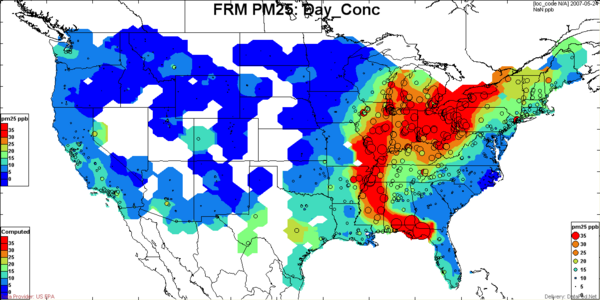 ]
]
Browser for: Airnow PM2.5
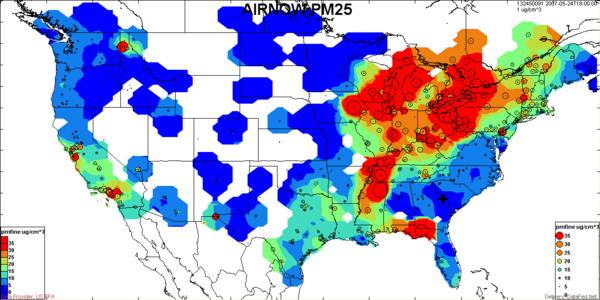
Observation: The top image represents the FRM PM mass concentration based on daily average filter samples. The bottom image shows the corresponding Airnow PM2.5 concentration as a snapshot of the hourly data at 18:00:00 UTC (12 PM Eastern Time). It is evident that on May 24, 2007 a large swath of the eastern U.S. had PM2.5 concentration above 35ug/m3. The FRM PM2.5 daily average filter sample concentrations (top figure) and Airnow Continuous Monitor PM Concentration (bottom) shows somewhat different spatial pattern. The PM2.5 mass measurements do not reveal whether these potential exceedances were due to known controllable emissions or due to exceptional causes.
2. Not Reasonably Controllable or Preventable
This line of evidence needs to establish that the event is 'not reasonably controllable or preventable'. The EE Rule identifes different categories of uncontrollable events:
- Exceedances Due to Transported Pollution (Transported African, Asian Dust; Smoke from Mexican fires; Smoke & Dust from Mining, Agricultural Emissions)
- Natural Events (Nat. Disasters.; High Wind Events; Wildland Fires; Stratospheric Ozone; Prescribed Fires)
- Chemical Spills and Industrial Accidents; Structural Fires; Terrorist Attack
Screening for Causes
Satellite Sensors Satellite images and satellite-derived aerosol products are useful for the identification of exceptional events such as biomass burning and forest and agricultural fires, wind-blown dust events. Both the satellite images as well as the numeric data products are generally available in near-realtime. A limitation of the satellite data is that they are semi-quantitative, particularly for estimating surface concentrations. Furthermore, satellite observations of surface-based aerosols are only available during cloud-free conditions.
May 24, 2008 Browser for: HMS Fire Pixels | May 27, 2008Browser for: HMS Fire Pixels
The fire pixels, obtained from satellite and other observations, provide the most direct evidence for the existance and location of major fires. In the above map of fire pixels, the cluster of fires in southern Georgia is evident.
The Absorbing Aerosol Index provided by the OMI satellite shows intense smoke in the immediate vicinity of the fire pixels. The lack of OMI smoke signal further away from the fires indicates an absence of smoke. However, it is also possible that the smoke is below the cloud layer and therefore not visible from the satellite. Also, the OMI smoke signal is most sensitive to elevated smoke layers, while near-surface smoke is barely detected.
The Aerosol Optical Thickness (AOT), derived from MODIS Sensors (Terra and Aqua satellites), shows a data void over Georgia due to clouds.
The true color MODIS images from Terra (11am) and Aqua (1pm) shows a rich texture of clouds, smoke/haze and land. The clouds over Georgia are clearly evident. Inspection of the images shows evidence of smoke/haze along the Mississippi River as well as over the Great Lakes.
On this day, 2007-05-24, the Tropospheric NO2 column concentration, derived from the OMI sensor, shows only a faint indication of the Georgia fire smoke. Here again, the obstruction by the clouds may be partly responsible for the lack of NO2 signal. Alternatively, the wet, low temperature smouldering fire in Georgia may not produce much NO2.
Auxiliary Observations In many areas quantitative observations of PM2.5 are available through additional monitoring networks. In some areas there are also local monitoring stations that can augment the large-scale observations. Sun photometers, measuring the vertical aerosol optical thickness, fall in this category.
Exceptional events are inherently noticeable because of the intensity of the short-time emissions and due to the unusual impacts they have on the atmospheric environment. The recent proliferation of continuously recording webcams, individual digital photographs and home videos as well as personal blog reports now constitute a significant new information source. Most of these observations are almost immediately placed on the internet, shared into internet-based repositories like YouTube for videos, Flickr for images and blogs for personal accounts. Given the high density and short response of these sensors to the exceptional events it is said that the Earth, has now acquired a "skin" for the detection of changes in the environment.
Automatic Harvesting of Florida Smoke-relavent Resources:
- Google Blog Search: Florida + Smoke
- Flickr: Florida+Smoke
Additional Human Filtering of Automatically Harvested Resources: By scanning the harvested resources (blogs and videos) deamed relevant to event analysis were tagged in del.icio.us. This added an additional human selection beyond automatic harvesting.
- Del.icio.us: 070508+Florida+Smoke
- Del.icio.us: 070508+Florida+Smoke+video
Observation: The satellite based fire pixels provide direct evidence of the southern Georgia fire and the satellite-based optical thickness values indicate the presence of substantial amount of emitted smoke. These provide evidence that there is a potential source for exceptional aerosol events due to biomass smoke. However, the satellite-based evidence is not adequate to indicate the magnitude of the surface concentrations relevant to air quality management. Auxiliary and qualitative observations can provide additional evidence and confirmation for the occurrence of exceptional events.
3. Clear Causal Relationship between the Data and the Event
There are multiple lines of evidence that can support the relationship between observations and the event. One approach is combining the observed source of an exceptional event with backtrajectories of high concentration events. In the figures below, we show the color coded concentration samples along with the backtrajectories which show the air mass transport pathway.
Backtrajectory Analysis
Given the availability of FRM PM2.5 concentrations, it is instructive to examine the backtrajectories (air mass histories) associated with above-standard concentrations. If those backtrajectories pass through areas of known exceptional sources (forest fires, dust storms), then the corresponding high concentrations may be attributed to that event.
On the other hand, if the backtrajectories pass through known anthropogenic emission regions, then those sources are likely responsible. Also if the backtrajectories indicate slow air mass motion in the vicinity of the receptor then atmospheric stagnation may be responsible for the accumulated high values.
Browser for: CATT FRM PM2.5 2007-05-24
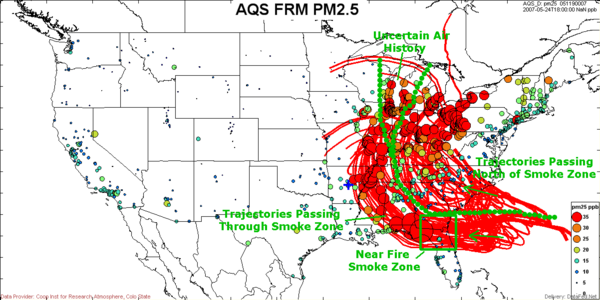
On May 24, the high concentration sites stretched from Alabama northward into the Ohio River Valley. The backtrajectories for all sites show a clockwise, anti-cyclonic circulation that brings marine air from the Gulf and Atlantic into the eastern U.S. The western bundle of trajectories, which result in high concentrations at receptor sites from Georgia through Illinois/Minnesota? are all passing through the Georgia fire region. These trajectories provide evidence that the smoke has impacted eastern U.S. sites that stretch all the way up to Minnesota/Illinois. On the other hand, the backtrajectories for the air masses reaching the Ohio River Valley are passing to the mid-atlantic states, well north of the Georgia fire. Therefore, those sites in the Ohio River Valley are not likely to be influenced by the smoke.
Browser for: CATT FRM PM2.5 2007-05-27
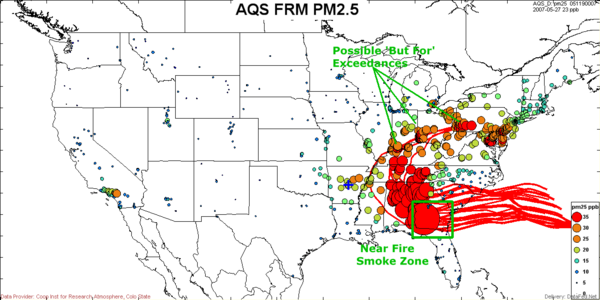
On May 27, virtually all the high concentrations were recorded just downstream of the Georgia fires. In fact, there was uniform flow of air transported from the Atlantic through Georgia toward Alabama and therefore the high concentrations could not have been caused by the long-term accumulation of anthropogenic sources.
Chemical Data
Speciated aerosol composition data provide a strong evidence for the impact of smoke on ambient concentrations. The figures below show the chemical composition data for sulfate and organics, respectively for May 24 and May 27.
Browser for: VIEWS May 24
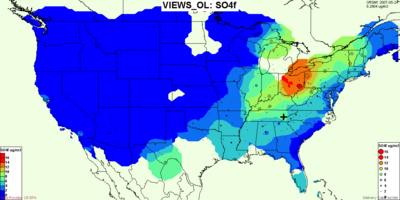
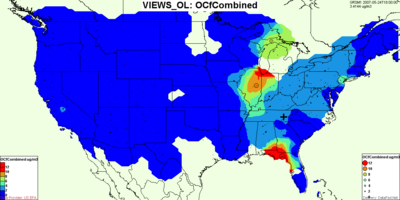
On May 24, the highest sulfate concentration was recorded just north of the Ohio River Valley. On the other hand, the highest organic carbon concentration is measured along the stretch from Georgia/Alabama to Wisconsin. This spatial separation of sulfate and organics indicates different source regions. Based on the combined chemical data and backtrajectories it is evident that the high PM concentrations that are observed along the western edge of the red trajectory path is due to the impact of the Georgia smoke. On the other hand the high PM2.5 concentrations just north of the Ohio River Valley are primarily due to known, controllable sulfate sources.
On May 27, the displacement of the sulfate and organics over the Eastern Uses is even more evident. The sulfates peak over the Virginia/Ohio/Pennsylvania, while the high concentration patch of organics is located over the southern states, Georgia/Alabama.
Model Simulations Model simulations and forecasts may also provide evidence for exceptional events. For example, the ability of regional and global-scale models for forecasting wind-blown dust events is continuously improving. This is evidenced by the good performance of the Naval Research Laboratory NAAPS global dust model. The simulation and forecasting of major smoke events is much more difficult due to the unknown space-time dependence of the smoke emissions. Hence, currently reliable and tested smoke forecast models do not exist.
Browser for: NAAPS NoAm, May 24, 2007
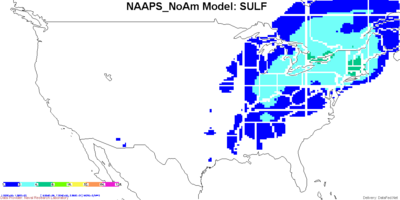
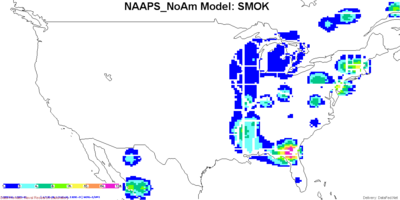
Conclusion: It is evident that on May 24, 2007 a large swath of the eastern U.S. had PM2.5 concentration above 35ug/m3. However, the PM2.5 mass measurements do not reveal whether these potential exceedances were due to exceptional causes.
4. The Event is in Excess of the "Normal" Values
For the samples flagged as exceptional, one has to demonstrate that the concentrations are well above the normal. A useful measure of the "normal" concentration is the median value over an extended period of time for a given station. In the tool settings below we have chosen a time setting of +/- 15 days (one month window), which is longer than a typical exceptional event while it is sufficiently short to preserve the seasonal variation of the concentration pattern. The magnitude of the event excess concentration is calculated as the concentration difference between the current daily concentration and the 30-day median concentration.
In the figures below, the concentration pattern are illustrated for two days 2007-05-24 and 2007-05-27. For each day the left most figure shows the measured day average PM2.5 concentration. The circles are color coded using the same coloring scheme as the contour for the concentration field. The middle figure shows the contour field for the 30-day median PM2.5 concentration. The color coded circles still represent the concentration for the selected day. The right most figure shows the excess concentration of the current day values over the 30-day median (both as contours and circles). While the right most figures show that the excess concentrations are high, these by themselves cannot establish whether the origin is from controllable or exceptional sources.
May 24, 2007
Browser for: FRMPM25_Day |
Browser for: FRMPM25_30DayMedian |
Browser for: FRMPM25_diff
May 27, 2007
Browser for: FRMPM25_Day |
Browser for: FRMPM25_30DayMedian |
Browser for: FRMPM25_diff
Observations: The FRM shows that on May 24, large swath of the eastern U.S. was covered with PM2.5 concentration well in excess 35ug/m3. The 30-day median concentration window, centered at May 24, shows that the highest median values were about 20ug/m3 stretching along the Ohio River Valley. The third figure, to the right, shows that the high excess concentrations over the median were confined to a well-defined plume that is narrow in the south and wider to the north. The deep blue areas adjacent to the PM plume indicate that large portions of the eastern U.S. were near the median values.
On May 27, the highest PM concentrations are shown as an arch, stretching northward from Georgia/Alabama toward the Ohio River Valley. The 30-day median values are virtually identical to those on May 24. The excess PM concentration to the left highlights the exceptionally high values over Georgia/Alabama in the vicinity of the Georgia smoke source. On the other hand, the excess concentrations over the Ohio River Valley are minimal. This provides evidence that on this day the Georgia smoke had significant impact in Georgia/Alabama. This is also confirmed by the backtrajectories shown in the section above.
5. The Exceedance or Violation would not Occur, But For the Exceptional Event
According to the EE Rule, observationas can be EE-flagged if the violation is caused by the exceptional event. Considering the subtleties of the EE Rule, below are graphical illustrations of the Exceptional Events criteria.
- The leftmost figure shows a case when the 'exceptional' concetration raises the level above the standard. A valid EE to be flagged.
- In the next case, the concentration from controllable sources is sufficient to cause the exceedance. This is not a 'but for' case and should not be flagged.
- In the third case, there is no exceedance. Hence, there is no justification for an EE flag.
Conclusion: It is evident that on May 24, 2007 a large swath of the eastern U.S. had PM2.5 concentration above 35ug/m3. However, the PM2.5 mass measurements do not reveal whether these potential exceedances were due to exceptional causes.
Data Views Used in this Analysis
<feed url="http://datafedwiki.wustl.edu/index.php?title=Data_Views_Catalog&action=feed&feed=rss" entries ="25">
- [{PERMALINK} {TITLE}]
</feed>
